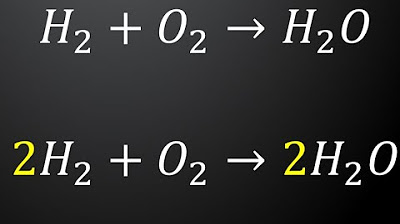cara agar mudah paham tentang penyetaraan reaksi kimia
Summary
TLDRIn this chemistry lesson, the instructor demonstrates how to balance chemical reactions. The first example focuses on the reaction between calcium carbonate (CaCO3) and hydrochloric acid (HCl), forming calcium chloride (CaCl2), water (H2O), and carbon dioxide (CO2). The instructor walks through the process of counting atoms and adjusting coefficients to balance the equation. In the second example, iron (Fe) reacts with sulfuric acid (H2SO4) to form iron sulfate (Fe2(SO4)3) and hydrogen gas (H2). Through careful examination, the instructor ensures all atoms are balanced, highlighting the key steps in chemical equation balancing for students.
Takeaways
- 😀 The video introduces a chemistry lesson focused on balancing chemical reactions.
- 😀 The first reaction discussed is the combination of CaCO3 and HCl to form CaCl2, H2O, and CO2.
- 😀 The process of balancing begins by listing the elements involved in the reaction: Ca, Cl, C, H, and O.
- 😀 The number of atoms of each element is calculated on both sides of the reaction.
- 😀 A methodical approach is taken to balance the number of atoms on both sides of the equation by adjusting coefficients.
- 😀 In the first example, after adjusting the coefficients, the reaction becomes balanced with all atoms matching on both sides.
- 😀 The second reaction involves Fe and H2SO4 reacting to form Fe2(SO4)3 and H2.
- 😀 Similarly, the elements involved in the second reaction are Fe, H, O, and S, which are also counted on both sides of the equation.
- 😀 Coefficients are adjusted in the second example to balance the atoms, including adding 3 to balance H2.
- 😀 The video concludes by successfully balancing both reactions and offering encouragement to students to understand the process.
Q & A
What is the topic of the video?
-The topic of the video is balancing chemical reactions, specifically focusing on how to balance the chemical equations of calcium carbonate (CaCO3) reacting with hydrochloric acid (HCl), and iron (III) sulfate (Fe2(SO4)3) reacting with sulfuric acid (H2SO4).
What is the first chemical reaction discussed in the video?
-The first reaction discussed is calcium carbonate (CaCO3) reacting with hydrochloric acid (HCl), resulting in the formation of calcium chloride (CaCl2), water (H2O), and carbon dioxide (CO2).
How does the instructor suggest balancing chemical reactions?
-The instructor suggests identifying all the elements involved in the reaction, counting the atoms of each element on both sides of the equation, and adjusting the coefficients until the number of atoms on the left side equals the number on the right side.
What was the initial challenge in balancing the first reaction?
-The initial challenge was that the number of chlorine atoms (Cl) and hydrogen atoms (H) were not balanced between the reactants and products.
How was the chlorine (Cl) balance fixed in the first reaction?
-The chlorine balance was fixed by adding a coefficient of 2 in front of HCl on the left side, ensuring that there were 2 chlorine atoms on both sides of the equation.
What is the second reaction discussed in the video?
-The second reaction is iron (III) sulfate (Fe2(SO4)3) reacting with sulfuric acid (H2SO4), resulting in the formation of iron (III) sulfate (Fe2(SO4)3) and water (H2O).
What was the main challenge in balancing the second reaction?
-The main challenge in balancing the second reaction was ensuring that the number of atoms for sulfur (S), oxygen (O), and hydrogen (H) were consistent on both sides of the equation.
How was the sulfur (S) atom balance fixed in the second reaction?
-The sulfur balance was fixed by adding a coefficient of 3 in front of H2SO4 on the left side, ensuring that there were 3 sulfur atoms on both sides of the equation.
How did the instructor address the hydrogen (H) balance in the second reaction?
-The instructor added a coefficient of 3 in front of H2 on the right side of the equation, ensuring that the number of hydrogen atoms on both sides of the equation was equal.
What was the final result after balancing both chemical reactions?
-After balancing both reactions, the instructor confirmed that the number of atoms for each element was equal on both sides of the equation, and the reactions were properly balanced.
Outlines

このセクションは有料ユーザー限定です。 アクセスするには、アップグレードをお願いします。
今すぐアップグレードMindmap

このセクションは有料ユーザー限定です。 アクセスするには、アップグレードをお願いします。
今すぐアップグレードKeywords

このセクションは有料ユーザー限定です。 アクセスするには、アップグレードをお願いします。
今すぐアップグレードHighlights

このセクションは有料ユーザー限定です。 アクセスするには、アップグレードをお願いします。
今すぐアップグレードTranscripts

このセクションは有料ユーザー限定です。 アクセスするには、アップグレードをお願いします。
今すぐアップグレード関連動画をさらに表示

Hukum Proust (Hukum Perbandingan Tetap) | Kimia SMA | Tetty Afianti

Video Pembelajaran Model Problem Based Learning Materi Persamaan Reaksi Kimia

Chemical Equilibrium Grade 12 Chemistry

BTEC Applied Science - Unit 5 Chemistry - Enthalpy Changes

11 клас. Хімія. Необоротні та оборотні хімічні реакції. Хімічна рівновага. Принцип Ле Шательє

Chemistry: Balancing Chemical Equations (Tagalog Explained)
5.0 / 5 (0 votes)
